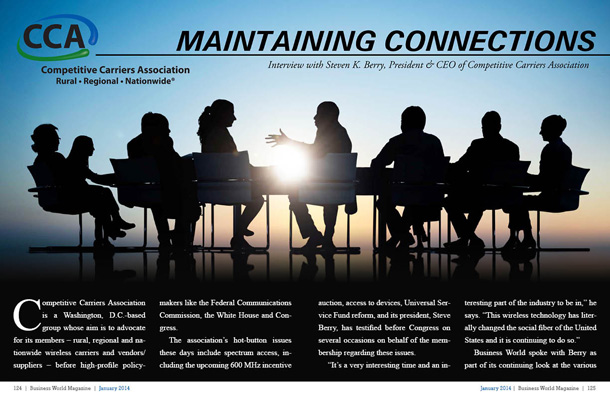
Maintaining Connections
Interview with Steven K. Berry, President & CEO of Competitive Carriers Association
Competitive Carriers Association is a Washington, D.C.-based group whose aim is to advocate for its members – rural, regional and nationwide wireless carriers and vendors/suppliers – before high-profile policymakers like the Federal Communications Commission, the White House and Congress.
The association’s hot-button issues these days include spectrum access, including the upcoming 600 MHz incentive auction, access to devices, Universal Service Fund reform, and its president, Steve Berry, has testified before Congress on several occasions on behalf of the membership regarding these issues.
“It’s a very interesting time and an interesting part of the industry to be in,†he says. “This wireless technology has literally changed the social fiber of the United States and it is continuing to do so.â€
Business World spoke with Berry as part of its continuing look at the various aspects of technology and the myriad associations that work on behalf of member businesses in their areas of industry.
BUSINESS WORLD: Can you give a sense of the history of the organization?
STEVE BERRY: It was originally formed by a group of smaller rural carriers because they found they not only needed a place to gather and to network and to share information, but they also needed a voice to focus on their policy issues that were unique to the rural and regional space. So, they came together and formed Rural Cellular Association (RCA). In Las Vegas, it started out as quite frankly as a meeting of friends in the wireless world, they played golf, and then they sat and talked about how they were going to deploy their networks and what was working and what wasn’t working. Twenty years ago, the wireless revolution was just beginning, so these carriers were pretty much pioneers in the world.
RCA’s membership expanded over the years just as the industry grew from a couple thousand wireless subscribers to over 300 million wireless subscribers in the United States. I came here a little over four years ago, which was about the time the Board decided they needed a strong effective policy voice in Washington, D.C. They needed someone to represent them before the FCC, Congress and the executive branch, and do so on a 24/7 basis in pursuit of their policy goals and aspirations to continue to thrive in the wireless world. In recent years as the industry has consolidated and become dominated by two national carriers, the membership has expanded further to include some of the small Tier I companies like Sprint and T-Mobile – providing a united voice for competitive carriers of all sizes.
On RCA’s 20th anniversary in September of 2012, we renamed the organization to CCA, the Competitive Carriers Association, to better reflect the makeup of our membership. CCA now essentially represents every carrier in the U.S. other than the largest two, and we have become the home for competitive carriers who want to ensure they can continue to compete in the industry. The reality became that our members – whether Tier I companies or small rural companies – all share a common goal of competition. The largest two carriers have such a different focus from everyone else in the industry, and these carriers needed a unified voice. So we changed the name to CCA, changed our board structure and increased the number of carriers and associate members to really take on the competitive policy issues head on.
CCA has essentially two roles. First, we’re an advocacy organization dedicated to pursuing those policy issues that are critical to the competitive industry, to competitive carriers. Second, we are a networking and informational hub for our members to get together and share ideas and experiences on how to most effectively deploy not only new technology, but to meet the challenges in the everyday world of devices and networks and all those very complicated tech demands that are placed on the small carriers. Not every one of these small carriers has an engineering and technology department, so our networking and informational events – our Global Expo and Annual Convention – provide real opportunities for smaller carriers to learn from one another.
While our events are an important part of CCA, we are clearly and primarily an advocacy organization. And as such, in recent years, we’ve changed almost every aspect of the association’s presentation to the policymakers in D.C. I think we have a very strong voice now. We are at the proverbial policy table in Washington, and I think our members are finding that we’re making a difference.
In just the last three years, we successfully opposed the AT&T/T-Mobile merger, demonstrating the importance of having an alternative voice. We vigorously pursued on our policy position, and the AT&T/T-Mobile merger did not happen. I happen to believe that CCA was one of the key components to bring the competitive policy and anti-trust issues front and center, not only before the Justice Department, but also the FCC and Congress. Our Chairman of the Board testified in the Senate, and I testified in the House. It was a pretty successful effort, but I think it was also a pretty large effort for the organization to be in a policy arena that was that critically important and have a successful outcome.
Last year, we played a critical role in ensuring that the FCC maintained the authority to create competitive auctions, which was a part of the Middle Class Tax Relief and Job Creation Act. The FCC is the expert agency when it comes to spectrum, and I am confident our voice was heard by Congress to ensure the FCC maintains this authority. The 600 MHz incentive auction is just around the corner in 2015, and the wireless industry is closely monitoring FCC actions as it continues to design the auction rules. The goal of the auction is to take the spectrum that broadcasters currently own and utilize, and turn it into high-speed mobile broadband spectrum, and it’s important for the FCC to get the rules right and ensure all carriers have the opportunity to participate.  One of the things we fought for was making sure the FCC can design competitive auctions so smaller carriers, competitive carriers, will have an opportunity to bid and potentially win in the 600 MHz auction. That was a huge win last year, which will both provide all carriers with meaningful opportunities to bid for needed spectrum and increase the total number of bidders, and in turn revenue, for use of a finite, taxpayer-owned resource.
Another huge policy win last year – interoperability. While interoperability was once a given in the wireless industry, over the last several years, AT&T and Verizon utilized nongovernmental standards setting bodies to create their own unique, boutique band classes with specifications for handset providers, so their devices would not operate on anyone else’s spectrum and vice versa. For a small carriers, not getting access to the latest, iconic devices can be devastating, and these actions left smaller carriers outside of an equipment “ecosystem.†With hard work of the Commission, support from Congress, and the leadership of then-Chairwoman Clyburn, the FCC forged an industry solution that will restore interoperability to the lower 700 MHz band. Interoperability will allow CCA members to build out nearly $2 billion worth of low band spectrum, which will help spur economic growth, create jobs and benefit consumers throughout the nation. This marked an important day for the wireless industry in the U.S., and I am very pleased CCA and our members remained steadfast in our commitment to ensuring interoperability became a reality. Going forward, we will need to make sure that there is interoperability in the upcoming 600 MHz band as well, so that carriers can bid with confidence knowing that they will be able to use any spectrum that they win.
BW: Another group that you’re working for, or another body that benefits from your work are all those customers that belong to those smaller carriers. That’s a lot of people, no?
BERRY: Absolutely. If you take our collective footprint, if you add Sprint, T-Mobile, C Spire Wireless, Bluegrass Cellular, Thumb Cellular and everyone else that’s currently a member, you’re talking about a third of the United States – roughly 80 million subscribers. We believe those consumers would like to have choices – for carriers, services and devices. And as small businessmen and women, we also understand that if consumers have choices and prices are regulated more by the marketplace, you don’t have to regulate the industry as much. Competitive pressures lead to new innovations. The entire wireless industry and especially consumers would benefit by having a framework for a competitive marketplace. CCA is focused on policy issues that will give these consumers new product innovations, especially in those most difficult to reach, hardest to build out and most difficult to serve regions of the United States.
CCA is trying to find pathways for our carriers to be able to continue to survive and hopefully thrive in the wireless arena. Another advocacy area we have been actively involved in is device unlocking. CCA has long supported allowing consumers to take the device of their choosing to the carrier that best meets their needs and desires. We took a strong position, and were the first trade group to support unlocking devices. I testified before Congress on this issue, and our efforts proved to be successful as the FCC recently spurred an industry solution for unlocking devices.  I hope Congress will finish the job and pass legislation as well. So yes, we are strongly focused on the competitive carriers, but we believe it has an immediate and an undeniable benefit to the consumer. And that’s where were trying to make our mark.
BW: Let’s touch on some of the other things that are tasking your energy and expertise these days in terms of public policy. Can you talk about Universal Service Fund reform?
BERRY: Yes, we have been actively involved in USF reform, the CAF – the Connect America Fund, and the Mobility Fund. We are very concerned that the FCC’s USF Order was far from the definition of what we would call a reform. The Order reduced support to wireless carriers by over 60%, which has negatively impacted competitive carriers – many of whom depend on this support to compete and even continue to provide existing services to consumers in hard-to-reach areas. Consumers are choosing wireless services more and more, and wireless may be in many cases the most efficient and most cost effective technology, yet support was reduced. We continue discussions with the FCC and Congress – it’s one of our goals coming up in the year ahead, to continue to seek reforms in the USF/CAF support programs. The FCC should aim to deploy available funding in a more competitively and technologically neutral way. We’d love to see consumer choice have an impact on where the money goes in rural America. It doesn’t make a lot of sense for the federal government program to support one type of technology in an area and basically say that if you want broadband, you can only get it from a wireline provider, especially when consumers are continuing to choose mobility. We have a hill to climb, but this is one of the areas that we will continue to focus on, absolutely. We are asking the FCC to think more innovatively about wireless solutions in the future.
BW: There’s another aspect of the organization to discuss, the Business Innovation Group.
BERRY: The Business Innovation Group (BIG) drives our Industry Development Programs and is essentially a committee of wireless carriers who meet regularly to develop new, innovative and scalable programs to meet their most immediate needs. The carriers identify their highest and most significant priorities, and they work together and think collectively to find a solution. Any CCA carrier member may join the BIG; it is a great way to meet people who are in similar situations, and participants benefit from maybe not one or two, but literally a dozen or two dozen company CEOs and CTOs that are confronting the same problems and finding solutions. CCA provides a platform that allows our carriers to share information and make better business decisions.
The BIG started three years ago, and it’s proving to be very useful for the small carriers that don’t have dozens of people working on a particular problem. When you’re as small as some of these carriers, this type of collaboration may really have an impact on your bottom line. The BIG initiatives also work hand-in-hand with our policy challenges, as we seek relief not only through public policy but also through industry solutions. I think these opportunities set us apart as a trade association from many others.
BW: Are there particular innovations or solutions that you can point to that were born from BIG?
BERRY: Yes, last year CCA created a Data Access Hub, which will be hosted by member company TNS. It is the first of its kind in the industry, and we’re very excited about it. Because roaming connectivity continues to be a problem for many carriers, especially those in rural and regional areas, CCA created the Hub to make connectivity much easier. CCA issued a formal request for proposal for organizations interested in hosting the Data Access Hub, and TNS was selected by the steering committee, made up of carrier members of various sizes and geographies.
The Hub will provide carriers a “one-stop shopping†opportunity for roaming, and better still – connectivity. Through the Hub, carriers will be able to sign one agreement and connect immediately to all other participating operators’ networks. And in the 4G world, if you’re a small carrier, you have to show your customers that you have a national footprint and that you can provide service wherever they travel in the United States. The Hub will provide this capability to carriers.  The goal is to always have access to one of the strongest networks and one of the strongest signals and the best service anywhere in the U.S. where our members have a footprint. The idea is to create an ecosystem where small carriers and the largest two small Tier 1 carriers, Sprint and T-Mobile, can cooperatively work together to provide coverage through the U.S. and then also become an international destination. So if you’re a Vodaphone or an Orange customer in Europe, you can come here with agreements through our Hub and have access to networks in the U.S. that provide you top-quality service. These are capabilities that smaller carriers would never have access to unless they had a direct relationship with one of the largest two carriers. What we’re trying to do is give our smaller carriers choices, and as such we also give the consumer multiple choices.
The Hub is one program the BIG has created. Another program the BIG designed is a Wi-Fi Offload Solution, in partnership with Boingo. To help carriers meet this growing demand and strain on their networks, Boingo is offering white-labeled Wi-Fi solutions to CCA carriers so their customers can connect to Boingo’s global footprint with one single account. This program will allow carrier a cost-effective option to help competitive carriers manage capacity constraints and better control data roaming costs.
CCA’s BIG is working on a number of different initiatives that will benefit our carriers, and ultimately consumers. While advocacy is our primary focus, these programs complement our advocacy work, and our members know that CCA is doing everything we can to help ensure they can compete and thrive in the industry.









